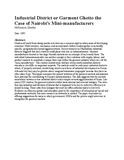| dc.description.abstract | Clusters of small firms doing similar activities are a common sight in urban areasof developing countries. Metal workers, mechanics, and second-hand clothes vendors gather in sectorally specific, geographically bound agglomerations. Recent research on Marshallian industrial districts suggests that such clusters could playa vital role in industrialisation.
Garment manufacturers located in two large Nairobi markets are an example of such small firms. The individual businessesresemble one another enough in their relations with supply, labour, and product markets to constitute a unique firm-type within the garment industry which we call the "mini-manufacturer". The clusters exhibit some features of successful industrial districts elsewhere, but differ in important respects. The markets could be embryonic industrial districts which, if properly nurtured, would bring about a new form of industrial development in Kenya. Alternatively they may be ghettoswhere marginal businesses congregate because they have no other place to go.
This paper examines the present situation of the garment markets and assessestheir potential for contributing to Kenya's industrialisation. The data suggeststhat the markets somewhere between a true industrial district and a simple sectoral agglomeration of firms. Like many LDC clusters, the
garment markets exhibit weak internal and external linkages. The inter-firm specialisation and division of labour that is supposed to be key to collective efficiency is almost lacking. Those inter-firm linkages that exist are often informal and at a low level. Evidence on ethnicity, gender and education point to the importance of entrepreneurs' social and professional networks, but more research on networks is needed. The paper concludes by- offering suggestions for ways in which government, NGOs and the private might intervene to strengthen the garment markets. | en |

